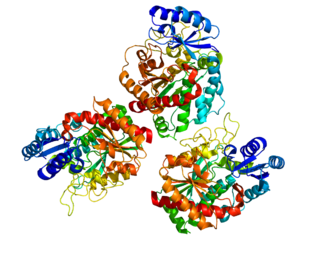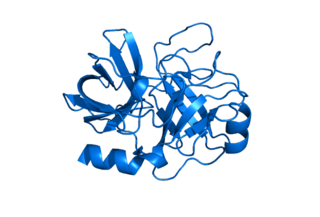
Prostate-specific antigen (PSA), also known as gamma-seminoprotein or kallikrein-3 (KLK3), P-30 antigen, is a glycoprotein enzyme encoded in humans by the KLK3 gene. PSA is a member of the kallikrein-related peptidase family and is secreted by the epithelial cells of the prostate gland in men and the paraurethral glands in women.

Acrosin is a digestive enzyme that acts as a protease. In humans, acrosin is encoded by the ACR gene. Acrosin is released from the acrosome of spermatozoa as a consequence of the acrosome reaction. It aids in the penetration of the Zona Pellucida.
Semenogelase is an enzyme. This enzyme catalyses the following chemical reaction
Kallikreins are a subgroup of serine proteases, enzymes capable of cleaving peptide bonds in proteins. In humans, plasma kallikrein has no known paralogue, while tissue kallikrein-related peptidases (KLKs) encode a family of fifteen closely related serine proteases. These genes are localised to chromosome 19q13, forming the largest contiguous cluster of proteases within the human genome. Kallikreins are responsible for the coordination of various physiological functions including blood pressure, semen liquefaction and skin desquamation.

Leucyl/cystinyl aminopeptidase, also known as cystinyl aminopeptidase (CAP), insulin-regulated aminopeptidase (IRAP), human placental leucine aminopeptidase (PLAP), oxytocinase, and vasopressinase, is an enzyme of the aminopeptidase group that in humans is encoded by the LNPEP gene.

Protein C inhibitor is a serine protease inhibitor (serpin) that limits the activity of protein C.

Kallikrein-1 is a protein that in humans is encoded by the KLK1 gene. KLK1 is a member of the peptidase S1 family.

Kallikrein-2 is a protein that in humans is encoded by the KLK2 gene, and is particularly associated with prostatic tissue.

Inhibin, alpha, also known as INHA, is a protein which in humans is encoded by the INHA gene.

Carboxypeptidase B2 (CPB2), also known as carboxypeptidase U (CPU), plasma carboxypeptidase B (pCPB) or thrombin-activatable fibrinolysis inhibitor (TAFI), is an enzyme that, in humans, is encoded by the gene CPB2.

Beta-microseminoprotein is a protein that in humans is encoded by the MSMB gene. For historical reasons, the scientific literature may also refer to this protein as Prostate secretory protein 94 (PSP94), microseminoprotein (MSP), microseminoprotein-beta (MSMB), beta-inhibitin, prostatic inhibin peptide (PIP), and inhibitin like material (ILM).

Kallikrein-related peptidase 4 is a protein which in humans is encoded by the KLK4 gene.

Kallikrein-11 is a protein that in humans is encoded by the KLK11 gene.

Semenogelin-2 is a protein that in humans is encoded by the SEMG2 gene.

Meprin A subunit beta is a protein that in humans is encoded by the MEP1B gene.

Cysteine-rich secretory protein 3 is a cysteine-rich secretory protein that in humans is encoded by the CRISP3 gene.

Kallikrein-8 is a protein that in humans is encoded by the KLK8 gene.

Kallikrein-15 is a protein that in humans is encoded by the KLK15 gene.

T-cell surface glycoprotein CD3 delta chain is a protein that in humans is encoded by the CD3D gene.
Semenogelin is a protein that is involved in the formation of a gel matrix that encases ejaculated spermatozoa, preventing capacitation. It blocks capacitation mainly via inhibition of reactive oxygen species (ROS) generation.

















